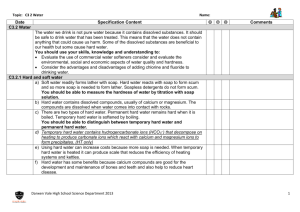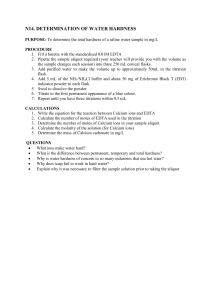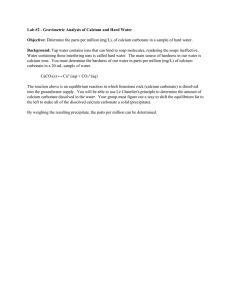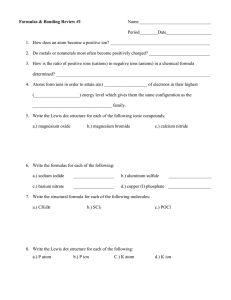Hardness of Water Chemistry Notes
advertisement
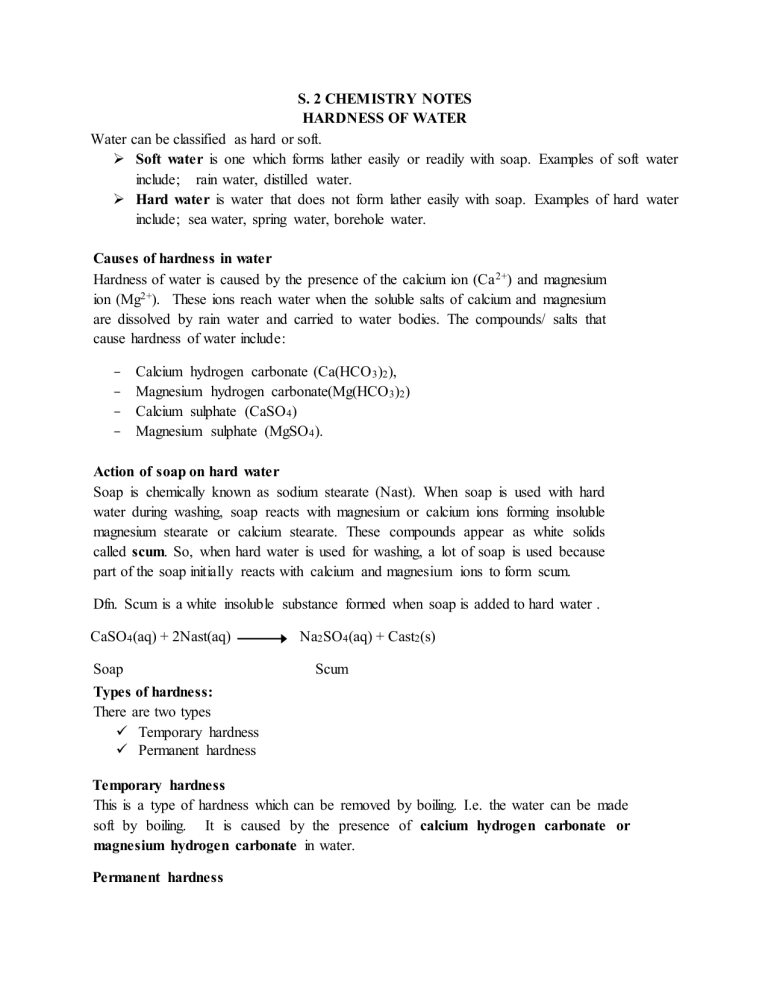
S. 2 CHEMISTRY NOTES HARDNESS OF WATER Water can be classified as hard or soft. Soft water is one which forms lather easily or readily with soap. Examples of soft water include; rain water, distilled water. Hard water is water that does not form lather easily with soap. Examples of hard water include; sea water, spring water, borehole water. Causes of hardness in water Hardness of water is caused by the presence of the calcium ion (Ca 2+) and magnesium ion (Mg2+). These ions reach water when the soluble salts of calcium and magnesium are dissolved by rain water and carried to water bodies. The compounds/ salts that cause hardness of water include: - Calcium hydrogen carbonate (Ca(HCO 3 )2 ), Magnesium hydrogen carbonate(Mg(HCO 3 )2 ) Calcium sulphate (CaSO 4 ) Magnesium sulphate (MgSO 4 ). Action of soap on hard water Soap is chemically known as sodium stearate (Nast). When soap is used with hard water during washing, soap reacts with magnesium or calcium ions forming insoluble magnesium stearate or calcium stearate. These compounds appear as white solids called scum. So, when hard water is used for washing, a lot of soap is used because part of the soap initially reacts with calcium and magnesium ions to form scum. Dfn. Scum is a white insoluble substance formed when soap is added to hard water . CaSO 4 (aq) + 2Nast(aq) Soap Types of hardness: There are two types Temporary hardness Permanent hardness Na2 SO4 (aq) + Cast2 (s) Scum Temporary hardness This is a type of hardness which can be removed by boiling. I.e. the water can be made soft by boiling. It is caused by the presence of calcium hydrogen carbonate or magnesium hydrogen carbonate in water. Permanent hardness Is a type of hardness which cannot be removed by boiling. I.e. the hard water cannot become soft on boiling. It is caused by presence of calcium sulphate or magnesium sulphate Note: Temporary hard water after boiling requires less volume of soap solution to form lather than the unboiled one. Permanent hard water even after boiling requires the same volume of soap solution to form lather as the unboiled. This is because even after boiling. Methods of softening water Removal of temporary hardness from water i) Boiling (physical method) Boiling decomposes calcium and magnesium hydrogen carbonates to their respective carbonates, water and carbon dioxide gas. The calcium and magnesium ions are removed as from water as insoluble carbonates and then deposited as solids at the bottom of boilers. Ca(HCO3)2(aq) CaCO3(s) CO2(g) H2O(l) ii) Addition of calcium hydroxide (lime water) Calcium hydroxide reacts with the soluble magnesium or calcium hydrogen carbonates to form insoluble magnesium or calcium carbonates. Ca(HCO 3 )2 (aq) + Ca(OH)2 (aq) iii) 2CaCO 3 (s) + 2H2 O(l) Adding sodium carbonate (washing soda): the calcium or magnesium ions are removed 𝐶𝑎(𝐻𝐶𝑂3 )2 (𝑎𝑞) + 𝑁𝑎2 𝐶𝑂3 (𝑎𝑞) → 2𝑁𝑎𝐻𝐶𝑂3 (𝑎𝑞) + 𝐶𝑎𝐶𝑂3 (𝑠) iv) Addition of aqueous ammonia The soluble hydrogen carbonates are converted into insoluble carbonates. This enables magnesium and calcium ions to be removed from wate. i.e; Mg(HCO3)2(aq) H2O(l) 2NH4OH(aq) MgCO3(s) (NH4)2CO3(aq) Method of removing permanent hardness i) Addition of sodium carbonate solution (washing soda) Sodium carbonate converts magnesium or calcium ions into insoluble carbonates. Na2 CO 3 (aq) + CaSO 4 (aq) Na2 SO4 (aq) + CaCO 3 (s) ii) Distillation : The soft water is collected as the distillate and the dissolved calcium and magnesium ions remain in the distillation flask as residue (expensive method). The water obtained by this method is pure. iii) Ion exchange method (permutit method) : used to soften water on a large scale. Hard water is passed through a chemical called permutit and the calcium and magnesium ions are removed by exchanging them for sodium ions. For example; MgSO4(aq) Na2Y(aq) 2Na2SO4(aq) MgY(s) This method works on the principle of exchange of ions. The calcium and magnesium ions are removed from during the process. Advantages of hard water 1. Hard water contains calcium which is important for formation of animal shells, bones and teeth. 2. Hard water tastes better and it is used in the brewing industry. 3. It prevents lead poisoning especially when lead pipes are used in transporting water. Disadvantages of hard water 1. Requires a lot of soap to form permanent lather hence wasting soap, 2. When hard water ids used for washing, it leaves dirty marks on cloth due to formation of scum. 3. Hard water forms kettle fur and boiler scales which are insulators, therefore a lot of fuel or electricity is used during boiling of water. 4. The boiler scales may block the pipes carrying boiling water hence causing the pipe to burst. Purification of water on a large scale This involves removing pollutants from water at a water purification plant. Tap water is a product of this process. The process involves four main stages: 1. Filtration: This is carried out to remove the solid particles. Water is made to pass through wire mesh screens to remove large and floating objects and then through sand and gravel to filter out smaller solid particles. 2. Sedimentation: Potash alum (potassium aluminium sulphate) is added to the water which makes fine particles to settle at the bottom and then filtered out using fine sand. 3. Chlorination: This involves adding an appropriate quantity of chlorine to water to kill harm full bacteria. 4. PH adjustment: This involves addition of sodium carbonate (soda ash) to neutralize the acidity created by chlorine in water. Trial questions. 1. Explain what is meant by hardness of water. What causes; i) Permanent hardness ii) Temporary hardness 2. Give methods that can be used to remove hardness from water. 3. Explain why soap does not form lather easily with hard water at first but eventually forms the lather later.
